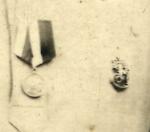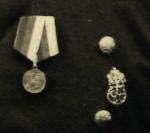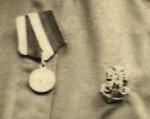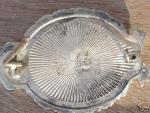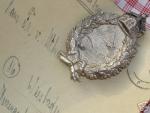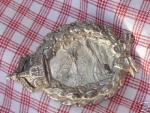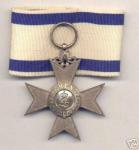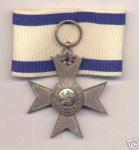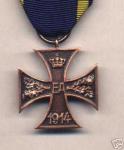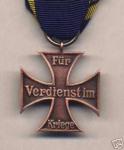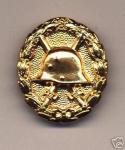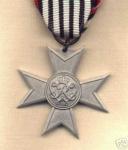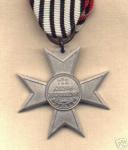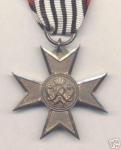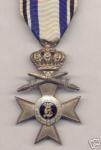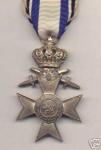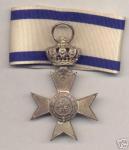-
Posts
949 -
Joined
-
Last visited
Content Type
Profiles
Forums
Blogs
Gallery
Events
Store
Everything posted by David Gregory
-

Imperial Russia Order of St. George
David Gregory replied to Chuck In Oregon's topic in Russia: Imperial
Chuck, That is a very attractive award. Can you recommend any sites that explain Imperial Russian awards in simple terms or provide a good primer for further enquiries? If I had the time, contacts and financial resources, this is another aspect of collecting militaria that I would like to pursue. Please consider a general lack of comments on my part as dumbstruck awe. Please show more, as I am sure there are many other collectors who simply know too little about them. Thanks in advance, David -

Austria-Hungary Iron Halfmoon Device
David Gregory replied to webr55's topic in Austro-Hungarian Empire
-

A Small Town In Germany: Nazi Mayor's Awards
David Gregory replied to a topic in State, Civil Awards & Decorations
At least his hands are in HIS coat pockets. -
Dave, RIR 32 was raised in Gera and intially commanded by Oberstleutnant von Hering of IR 32 (KIA 7 September 1914). I. Bataillon was raised from men taken from IR 95 under the command of Major von StockhausenII. Bataillon was raised from men taken from IR 96 under the command of Major UhlenhautIII. Bataillon was raised from men taken from IR 95 under the command of Major von HertellThe regimental losses are given as 58 officers and 1792 NCOs and other ranks. RIR 252 was raised by Stellv. Gen. Kdo. XI. A. K. at Truppen-?bungs-Platz Ohrdruf from: Feldbataillon 57 in Sondershausen by Ersatz-Bataillon/IR 71Feldbataillon 58 in Coburg by Ersatz-Bataillon/IR 95Feldbataillon 59 in Rudolstadt by Ersatz-Bataillon/IR 96The regimental staff was raised by Ersatz-Bataillon/IR 71. Date of establishment was 29 December 1914. The regiment was assigned to 76. Reserve-Division and commanded by Major Laue of F?silier-Regiment Nr. 35. The battalions were commanded as follows:I. Bataillon under the command of Major BachfeldII. Bataillon under the command of Hauptmann GrauIII. Bataillon under the command of Major H?bnerThe regimental losses are given as 40 officers and 2288 NCOs and other ranks. Another unit with a probable Reuss contingent was Landsturm-Infanterie-Regiment Nr. 11, which was raised on 16 June 1916 by Stellv. Gen. Kdo. XI. A.K. and assigned to 8. Armee. Its two battalions were raised from Landsturm-Infanterie-Bataillon XI. 22 and Landsturm-Infanterie-Bataillon XI. 23. Replacements were provided by Ersatz-Bataillon/Landsturm-Infanterie-Regiment Nr. 11 (XI. 27) (Ohrdruf) and demobilised by IR 71. Many Landwehr and Landsturm men from Reuss were used as replacements for various units throughout the war. Some units were raised in Gera and used elsewhere, e.g.: III./Landwehr-Infanterie-Regiment Nr. 71 commanded by Major a.D. Ulrich was raised in Gera2. Landsturm-Infanterie-Bataillon Gera (XI. 13) was mobilised on 17 August 1914 and served with Gouvernement Belgien as part of 2. Armee2. Landsturm-Infanterie-Bataillon Gera (XI. 25) was mobilised on 10 February 1916 and was assigned to 10. Armee, Armee-Abteilung D, Heeresgruppe Kiew, 1. bayerische Kavallerie-DivisionOberst z. D. von D?cker, Bezirkskommandeur for Gera, took command of RIR 206, so Reuss awards might have been bestowed on men that served with that unit, too. This information was taken from Hartwig Busche's Formationsgeschichte der deutschen Infanterie im Ersten Weltkrieg 1914-1918. I'll check my Milit?rpass entries for Reuss awards and add those later David
-

EK 1914 Eiserne Kreuz 101....
David Gregory replied to joe campbell's topic in Germany: All Eras: The Iron Cross
Considering the level of destruction in German cities and the amount of displaced persons having to start from scratch in the immediate post-war period, it would not surprise me that there would be demand for replacement medals for ageing WW1 veterans. That demand may have been met by surviving old stocks to a certain extent, but the major producers and suppliers would almost certainly have catered to the elderly vets as well as those willing to wear what they had been awarded in the 1939-45 period. -
Rick, Thanks for identifying the medal. The photo came from German eBay some time in the last year or so and, if I recall correctly, was one for which I bid Euro 1 simply to mark it. No one else bid on it, so it inadvertantly became mine. Only by checking the back of photos is it sometimes possible to reunite groups split and sold over a longer period of time. I wonder if our photos were taken within the same short time frame or in the same area. I had assumed that the photographer was attached to a higher level unit such as a division or Korps somewhere on the Eastern front, much the same as some of the court photographers accompanied units from specific states (Mecklenburg, for example). I know next to nothing about the Russian OOB, but it would be interesting to find out when and where the Russian 102nd Infantry Regiment served and which German formation captured the NCOs. Judging by the state of dress of the men in both images, either the propaganda machine was hard at work or they do not seemed to have suffered much from the ravages of war when the photos were taken. Has anyone a clue as to the badges the NCOs are wearing and does anyone have an example to show? Many thanks in advance, David
-
According to the printed caption written on the back, this photo was taken by "Photo-Atelier Haase, G?hren a. R?g.Charlottenburg Tauroggenstr. 4. z. Zt. im Felde". The handwritten comment reads "Russians of the 102nd Regiment captured in Nowo-Alexandrowsky. 3 NCOs." [attachmentid=16420] Details from left to right: [attachmentid=16421] [attachmentid=16422] [attachmentid=16424] I assume that the medals and badges worn by all three men are the same. Unfortuanately, I have no other information on the context of this photograph. Any information on the awards would be greatly appreciated. David
-
Rick, Thanks for the very informative reply. Like many other collectors, I would be happy to acquire an authentic flight badge. However, this is one award for which no amount of homework will be too much before I part with any money. The price you quote puts an entirely new perspective on it. A simple stamped steel issue piece, if it is good, can be had from a Hamburg dealer for less than Euros 400. Is that an indication that the badge is not good or are the issue pieces so much cheaper? David
-

Strange BWM
David Gregory replied to Chris Boonzaier's topic in Great Britain: Orders, Gallantry, Campaign Medals
Chris, I'd leave it as it is. If you display the medal like the rest you have, the loop probably wouldn't be apparent as the ribbon would hide it. Just a thought from someone who learned not to "improve" things by trying to return them to their original state (the hard way). David -

Moroccans, Belgian Agents and a big nosed Spaniard...
David Gregory replied to Chris Boonzaier's topic in Africa
Chris, A very nice selection and an instant French colonial collection. Are there any variants of the Croix de Guerre that you don't yet have? Do you any nice 1914-15 or 1914-17 examples of the Croix de Guerre surplus to requirements? Any ideas when and where the citation recipient was serving when he was killed and which German units were facing him? Cheers, David -
That is an impressive collection, indeed, Mike. To avoid conflicts with my other half due to the space taken up by field equipment, helmets and other hardware, I changed my collecting focus (mainly) to documents some time ago. However, researching documents requires a lot of literature, so I now have to justify the lack of bookshelf space. Never mind. David
-

Belgium Belgian order of Leopold ll
David Gregory replied to Laurence Strong's topic in Northern European & Baltic States
Dave, Thanks for showing those awards, which are the sort of approximate front-line soldier's "equivalents" that I am looking for to match the German ones I have. How do the earler and later Croix de Guerre types differ? Specifically, which are typically for 1914-18 and which are much later? What are the other differences between the earlier and later orders apart from the language? Many thanks in advance, David -

Belgium Belgian order of Leopold ll
David Gregory replied to Laurence Strong's topic in Northern European & Baltic States
Laurence, These are very attractive awards. After only a passing interest, I abandoned Third Reich awards a few years ago (but paperwork still fascinates me). My main interest lies in Imperial German documents and the more common awards, but I have been led astray by some French and British awards and documents of the 1914-18 period. With the exception of a victory medal, I still have nothing to represent Belgium's part in the Great War. This is another collecting field that is sorely tempting. Do these awards date from that period or are they more recent? Were these awarded for merit or valour? Do you have examples of any award documents? David -

Heer Anti-Partisan Badge in Gold
David Gregory replied to Gordon Williamson's topic in Wehrmacht Medals, Decorations & Awards
Or Imperial flight bages, for that matter ... -
Spelling changes in real names like this are not unusual in German. At around the same time that the P?llath/Poellath variants were in use, even the names of towns and cities were changing. When I travel to work by train, I pass the gable end of a building next to the railway embankment that still bears a faint sign with the name Coeln (today's K?ln) from the time when the line was part of the Coeln-Mindener Eisenbahngesellschaft (later swallowed by the Prussian state railway).
-
The seller has been offering these items for over a year now, probably longer in fact, and offers the same awards with the same ageing/finish with monotonous regularity Most of the crosses and medals he sells display the same poor casting quality and the same finish, which ranges from a dull silver-grey to a coppery finish, depending on the base metal, usually discoloured by either the casting process or what looks like an acid wash. Christian pointed out one of his typical cast fakes at http://gmic.co.uk/index.php?showtopic=1205 To be honest, I am not entirely sure about the Bavarian crosses, but I find it impossible not to condemn them by association. They consistently lack the bright finish usually found on the majority of known originals. The Iron Crosses have been discussed at WAF before and i see no reason to doubt the conclusions drawn there. I know that at least one member here has bought examples of the Verdienstkreuz f?r Kriegshilfe in aluminium and silver, but I will leave it up to him or anyone else who has handled one to comment in detail. I posted an example of a Hessen Kriegerehrenzeichen in Eisen he offered a while ago at http://gmic.co.uk/index.php?showtopic=1073...etensammlerclub Watch his auctions for a while and you will see how he keeps offering the same awards with exactly the same finish time after time. The Bavarian crosses, if they are also fakes, which I strongly suspect, represent an entirely new and expensive copy that should be treated with caution. Perhaps I am paranoid, but there are enough other collectors who consider his goods to be bad. Send him a mail and ask him about the originality of his pieces. The reply he sent me was careful and evasive. David
-
A little less hard on your eyes: Bavarian Milit?r-Verdienst-Kreuz 2. Form 1905 - 1913, 2. Klasse. Now on offer, if you dare, for only EUR 400 in eBay auction #6224170924 [attachmentid=15141] [attachmentid=15142] Another slow mover, but he does sell a few with monotonous regularity - Milit?rdienstauszeichnung Baden f?r 15 Jahre, Spange for only EUR 180 offered in eBay auction #6224169758. Described as being made of solid silver, marked 800 J.PETRY on the back: [attachmentid=15144] His fake iron crosses also sell well, but someone else can post images of them. At least he is careful enough to use different images for each EK that he offers. He has also offered Hindenburg crosses in the past, but I can't find an image of one for the time being. David
-
Braunschweig war merit cross 2nd class "An excellent bronze piece in very good condition" sold in eBay auction #6550410632 for EUR 46. This is one the poorer quality examples that he offers regularly: [attachmentid=15134] [attachmentid=15135] Erinnerungskreuz TREUEN KRIEGERN, made of solid bronze, sold in eBay auction #6197657398 for EUR 24.99 (his normal price): [attachmentid=15137] Migrane-inducing Verwundetenabzeichen in Gold sold in eBay auction #6197654518 for EUR 66: [attachmentid=15138] He offers all of these items quite regularly.
-
Verdienstkreuz Kriegshilfe made of aluminium, eBay auction #6207207411, sold for only EUR 40 (he usually sells them for EUR 65): [attachmentid=15131] [attachmentid=15132] Verdienstkreuz Kriegshilfe made of solid silver, eBay auction #6206473187, sold for his usual price of EUR 75: [attachmentid=15133] The only good crosses I know of are made of finely-cast zink. Are any real ones in aluminium or silver actually known? David
-
A number of Imperial awards that are generally accepted as fakes are regularly offered on German eBay by seller raritaetensammlerclub, who also offers his products on his website at http://www.ordensammler.com By a strange coincidence, some of his goods have also been bought and sold by German eBay user cetra2003 who is based in T?bingen. The payment details for http://www.ordensammler.com give a bank account belonging to Christine Traub of T?bingen. Am I paranoid or is it just a coincidence that cetra2003 (C_TRA___) is also based in T?bingen? baff002, a well-known purveyor of fake medal bars, also buys ribbon stock from raritaetensammlerclub. Another coincidence? Perhaps. Before they disappear, here are a few of the latest eBay offerings by raritaetensammlerclub and the prices they fetched. They were all offered with a full description of the materials and he even quotes the OEK number. However, the description carefully avoids any mention of originality. Bavarian Milit?r-Verdienstkreuz 3. Form 1913 - 1918, 2. Klasse, mit Schwertern und Krone, eBay auction #6221813779, sold for EUR 162.01, described as made of solid silver: [attachmentid=15125] [attachmentid=15126] Bavarian Milit?r-Verdienstkreuz 3. Form 1913 - 1918, 2. Klasse, mit Krone, eBay auction #6221809607, sold for EUR 200, described as made of solid silver: [attachmentid=15127] [attachmentid=15128] Bavarian Milit?r-Verdienst-Kreuz 2. Form 1905 - 1913, 2. Klasse, with swords, eBay auction #6217894041, sold for EUR 685 , described as all parts made of solid silver. Perhaps this scored such a high price due to the lack of enamel, which makes it a little unusual: [attachmentid=15130] Your thoughts? David



